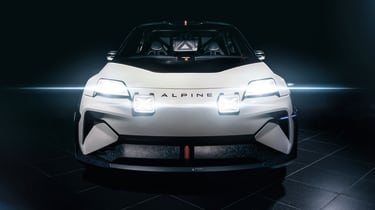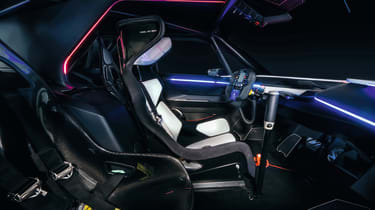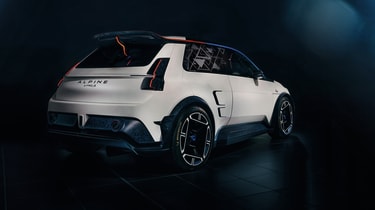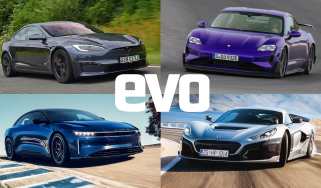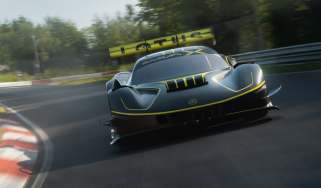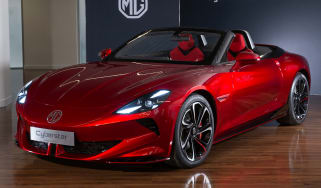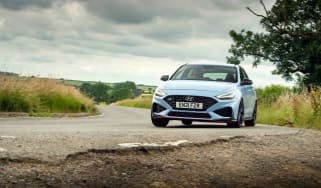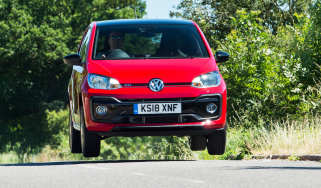Alpine's A290 electric hot hatch will be unveiled at Le Mans
Alpine will pull the covers off its A290 hot hatch on 13 June, coinciding with the 24 Hours of Le Mans
Reports of the death of the hot hatch are greatly exaggerated – at least that’s what Alpine would have us believe. Having teased us with the A290_β concept last year, the firm has announced that the production-spec A290 EV hatch will be unveiled at Le Mans on 13 June.
The A290 will be based on the new Renault 5, albeit with a more performance-oriented character to go head-to-head with the Mini Cooper SE and Abarth's 500e. Not only will it boast more power than its R5 relation, but it will benefit from bespoke hardware and software tuning for a more engaging driving experience. Having driven a prototype in Sweden earlier this year, the A290 shows signs of living up to that promise.
> Alpine A290 prototype review – first taste of the electric hot hatch
Dimensionally the A290 is reasonably compact at 3990mm long, 1820mm wide and 1520mm high, with a 2530mm wheelbase. Think a bit smaller than the Hyundai Ioniq 5 and a bit bigger than the Honda E. Or, in old hot hatch terms, it’s around 400mm shorter but very similar in width and height to the last generation Mégane RS.
Weight-wise, Alpine says the A290 will be sub-1500kg. (For reference, that same Mégane RS weighed 1440kg.) It will feature a single, front-mounted motor powering the front axle. No performance figures or price have been announced as yet, but we do know that it will be built at Renault’s Douai plant alongside the Mégane E‑Tech.
Invited to a recent deep-dive tour of the brand’s key factories, we chatted with Alpine’s vice-president of vehicle engineering, Roberto Bonetto, who described the A290 as a driver’s car of real finesse, rubbing both thumbs and forefingers together to emphasise its pursuit of feel and connection. ‘We have worked very hard on the way the throttle and brakes respond, the tip-in/tip-out behaviour. We are honing the way the hydraulic and regen braking merge and have created a torque delivery that is much more driveable and enjoyable compared to the typical and rather unpleasant EV way. We are really focused on these important qualities.’
The A290 will have multi-link rear suspension and use passive dampers with hydraulic bump-stops. Tyres have been developed specifically for Alpine by Michelin to try to reconcile the conflicting goals of low rolling resistance and high grip. A disguised prototype we saw in the workshop was fitted with 19-inch rims. There is talk of several tyre options, which suggests there might be an optional performance package. Here’s hoping. The braking system uses the same four-piston calipers as the A110, while control software that blends hydraulic and regen braking benefits from Alpine’s experience in Formula E. The chassis tune is described as ‘playful’ with an emphasis on agility – something EVs are not noted for.
The differences between the A290’s powertrain and that of the R5 are promised to be greater than those we know from the old Renault Sport days. Multiple dynamic modes promise to offer plenty of scope to adjust the car’s character, and there’s more fun to be had with a boost button on the steering wheel.
What’s clear is that Alpine is taking the business of building an EV hot hatch extremely seriously. Vice-president of product performance Sovany Ang was emphatic in her assurance that they want to major on authenticity. ‘What I feel and hear must be real,’ she said, adding ‘the defining sound quality will not be fake.’
With only a disguised prototype to compare with the A290_β (as pictured here) it’s hard to be definitive on the production A290’s styling. What we do know is that it will have five doors and a much more conventional cockpit. Less aggressive aerodynamic addenda too, though Ang referenced the value of Alpine’s F1 aero knowledge in reducing drag, improving cooling and boosting efficiency – factors vital in enabling a sporting EV to give its best at all times. ‘Temperatures and the state of charge should not limit performance,’ added Ang in a further nod to the A290’s motorsport influences.
When Renault closed down its performance sub-brand, Renault Sport, many of the team responsible for the great RS hot hatches stayed on and are now working at Alpine. Combined with the exceptional A110, which is one of the greatest sports cars of the modern era, it lends more credibility to words that could otherwise be taken with a healthy pinch of salt.
The famous Dieppe plant is where it all began, and where the A110 is built today, but this manufacturing base is just part of Alpine’s expansive operation, the highest profile activity being the Alpine Racing Formula 1 team. It was a tough 2023 season, but being part of the hottest sport on the planet is going to pay dividends as Alpine’s range expands from today’s A110 sports car to a promised seven-car EV line-up by 2030.
The raft of EVs suggests a wholesale abandonment of internal combustion, but in a revealing comment, Bonetto made a point of saying: ‘Our target is zero emissions. That’s not necessarily EV only. We are open to other solutions, maybe hydrogen.’
> New Renault 5 unveiled – meet the basis for Alpine’s electric hot hatch
Unlike F1 teams who buy-in customer engines, Alpine is a full constructor with its own in-house powertrain department. Based at the team’s Viry-Châtillon facility, more than 350 people are employed in the design and development of Alpine’s F1 and WEC Hypercar powertrain programmes.
F1’s engine regs are due for a major change in 2026, when teams switch to a simpler combination of a sustainable fuel-powered V6 and beefed-up MGU‑K hybrid system, but beyond that hydrogen has been mooted as a long-term solution to the sport’s pursuit of net zero. According to Alpine Racing’s vehicle director, François Champod, they are already making meaningful progress with the alternative fuel: ‘We’re working hard on hydrogen internal combustion engines. There is a version of this which is running here at Viry.’ Given that Ineos – one of Europe’s largest producers of hydrogen – is a 33 per cent stakeholder in the Mercedes F1 team, the push towards a sustainable ICE solution has serious weight behind it.
Lessons learnt in the push for a potential new F1 engine will undoubtedly expand knowledge and accelerate development. And if hydrogen were to be adopted by F1, those directly involved in its implementation would be perfectly placed to champion the new ICE age without undermining whatever EV strategy they already have in place.
For now, Alpine’s primary focus is bringing its family of EVs to market. This begins this year with the A290, to be closely followed by an all-wheel-drive, twin-motor 89kWh crossover GT. Codenamed DZ110 and scheduled for launch in 2025, it will be built at Dieppe alongside the A110. Alpine execs are tight-lipped about what follows, but the battery-powered A110 E‑ternité prototype and hydrogen-powered Alpenglow concept point to an ongoing commitment to zero-emission sports cars.
We all mourned the winding-up of Renault Sport, for it marked the end of an era that had brought us so many fine hot hatches. Renault’s half-baked resurrection of the Gordini nameplate didn’t help matters. But as we learn more about its plans, Alpine is beginning to make much more sense as Renault’s standalone sporting brand. Most importantly, with these latest details about the A290, it feels like Alpine’s vision of the future is much more aligned with our hopes. We’ll find out soon enough.
This story was first featured in evo issue 318.
